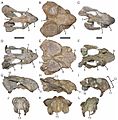| DescripciónBulbasaurus-7.jpg |
English: Figure 7: Comparisons of Bulbasaurus with Tropidostoma and Aulacephalodon.
Specimens: Tropidostoma dubium (SAM-PK-K11238) in (A) dorsal, (D) ventral, (G) right lateral, and (J) anterior views. Bulbasaurus phylloxyron (CGP/1/938) in (B) dorsal, (E) ventral, (H) right lateral, and (K) anterior views. Aulacephalodon bainii (BP/1/3744) in (C) dorsal, (F) ventral, (I) right lateral, and (L) anterior views. Specimen of Bulbasaurus largely undistorted; specimens of Tropidostoma and Aulacephalodon have suffered some lateral compression. Scale bars equal 5 cm; all figures of an individual specimen to scale with one another. Characters: 1, intertemporal exposure of parietal: elongate, narrow channel in Tropidostoma, ‘pinched’ but anteriorly broad in Bulbasaurus, and broad throughout but transversely expanded posteriorly in Aulacephalodon. 2, postfrontal: large and triangular in Tropidostoma, absent in Bulbasaurus and large specimens of Aulacephalodon. 3, interorbital width: narrow in Tropidostoma, relatively broad in Bulbasaurus and Aulacephalodon. 4, nasal bosses: discrete and widely-separated, transversely narrow, ovoid, smooth bosses in Tropidostoma, large, rugose bosses covering almost all of nasal surface and nearly meeting on midline in Bulbasaurus, and large, rugose, but discrete and widely-separated bosses in Aulacephalodon. 5, quadrate ramus of pterygoid: relatively thin in Tropidostoma, relatively thick in Bulbasaurus and Aulacephalodon. 6, anterior ramus of pterygoid: relatively thin in Tropidostoma, relatively thick in Bulbasaurus and Aulacephalodon. 7, postcanine teeth: present in Tropidostoma, absent in Bulbasaurus and Aulacephalodon. 8, maxillary tusk: relatively small in Tropidostoma, massive in Bulbasaurus, also massive in Aulacephalodon but only at large skull size—specimen figured here is at minimal size for large tusks in the taxon; smaller individuals have thin or just-erupting tusks. 9, depression between anterior palatal ridges: deeper than depressions lateral to ridges in Tropidostoma, of equal depth as lateral depressions in Bulbasaurus and Aulacephalodon. 10, subtemporal bar: with only a slight deflection of the dorsal edge in Tropidostoma, ‘twisted’ in Bulbasaurus, such that the medial surface of the bar becomes the dorsal surface posteriorly, and strongly ‘twisted’ in Aulacephalodon, such that the medial surface of the bar becomes the lateral surface posteriorly. 11, ‘beak’: with only weak curvature in Tropidostoma and Aulacephalodon, only extreme anterior edge with hooked tip, versus strongly ventrally-curved in Bulbasaurus, with most of premaxillary ventral margin making up hooked tip. 12, snout depth: very deep in Aulacephalodon, comparatively shallow in Tropidostoma and Bulbasaurus. 13, anterior premaxillary ridge: absent or weakly-diffuse in Tropidostoma, very discrete and well-developed in Bulbasaurus, and absent in smaller individuals of Aulacephalodon such as the one figured here (and even in the largest adults, the premaxillary ridge of Aulacephalodon is proportionally lower and more diffuse than that of Bulbasaurus). |


